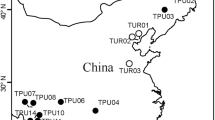Abstract
The genetic relatedness between the green and red forms of the two-spotted spider mite, Tetranychus urticae Koch, was analysed using an allozyme marker, MDH, detected by polyacrylamide gel electrophoresis. Cross experiments showed that each of the two forms had form-specific alleles for MDH. Furthermore, there was no overlapping in the alleles for MDH between the field populations of the two forms, suggesting that no gene flow would occur between them in the field.
Similar content being viewed by others
References
Boudreaux, H.B. 1956. Revision of the two-spotted spider mite complex, Tetranychus telarius (Linnaeus). Ann. Entomol. Sco. Am. 49: 43–48.
Boudreaux, H.B. 1958. The effect of relative humidity on egg-laying, hatching, and survival in various spider mites. J. Insect Physiol. 2: 65–72.
De, Bach, P. 1969. Uniparental, sibling and semi-species in relation to taxonomy and biological control. Israel J. Entomol. 4: 11–28.
Dosse, G. and Boudreaux, H.B. 1963. Some problems of spider mite taxonomy involving genetics and morphology. In: Advances in acarology 1, J.A., Naegele (ed.), pp. 343–349. Cornell University Press, New York.
Dupont, L.M. 1979. On gene flow between Tetranychus urticae Koch, 1836 and Tetranychus cinnabarinus (Boisduval) Boudreaux, 1956 (Acari: Tetranychidae): synonomy between the two species. Entomol. Exp. Appl. 25: 297–303.
Ehara, S. 1975. [Classification.] In Nougyoudanigaku, S., Ehara and N., Shinkaji (eds), pp. 55–132. Nougyoudanigaku. Zenkoku-nouson-kyouiku-kyoukai, Tokyo (in Japanese).
Ehara, S. 1989. [Recent advances in taxonomy of Japanese tetranychid mites.] Shokubutu-boeki 43: 358–361 (in Japanese).
Goka, K. and Takafuji, A. 1992. Enzyme variations among Japanese populations of the two-spotted spider mite, Tetranychus urticae, Koch. Appl. Entomol. Zool. 27: 141–150.
Goka, K. and Takafuji, A. 1995a. Genetic basis of esterase, malate dehydrogenase and phosphogluco-isomerase allozymes in the two-spotted spider mite, Tetranychus urticae Koch. Appl. Entomol. Zool. 30: 529–535.
Goka, K. and Takafuji, A. 1995b. Allozyme variations among populations of the two-spotted spider mite, Tetranychus urticae Koch, in Japan. Appl. Entomol. Zool. 30: 567–579.
Gotoh, T. and Shinkaji, N. 1981. [Critical photoperiod and geographical variation of diapause induction in the two-spotted spider mite, Tetranychus urticae Koch (Acarina: Tetranychidae).] Jpn. J. Appl. Entomol. Zool. 25: 113–118 (in Japanese with English Summary).
Gotoh, T. and Tokioka, T. 1996. Genetic compatibility among diapausing red, non-diapausing red and diapausing green forms of the two-spotted spider mite, Tetranychus urticae Koch (Acari: Tetranychidae). Jpn. J. Entomol. 64: 215–225.
Helle, W. and Overmeer, W.P.J. 1973. Variability in tetranychid mites. Ann. Rev. Entomol. 18: 97–120.
Helle, W. and Van de, Bund, C.F. 1962. Crossbreeding experiments with some species of the Tetranychus urticae group. Entomol. Exp. Appl. 5: 159–165.
Jordaan, L.C. 1977. Hybridization studies on the Tetranychus cinnabarinus complex in South Africa (Acari: Tetranychidae). J. Entomol. Soc. S. Afr. 40: 147–156.
Osakabe, Mh. 1991. Esterase isozyme patterns corresponding to differences in diapause attribute among populations of the citrus red mite, Panonychus citri (McGregor) (Acari: Tetranychidae). Bull. Fruit Tree Res. Stn 21: 85–94.
Osakabe, Mh. and Komazaki, S. 1996. Differences in esterase isozymes between Panonychus citri populations infesting citrus and osmanthus. Exp. Appl. Acarol. 20: 113–119.
Parr, W.J. and Hussey, N.W. 1960. Further studies on the reproductive isolation of geographical strains in the Tetranychus telarius complex. Entomol. Exp. Appl. 3: 137–141.
Takafuji, A., So, P.-M. and Tsuno, N. 1991. Inter- and intra-population variations in diapause attribute of the two-spotted spider mite, Tetranychus urticae Koch, in Japan. Res. Popul. Ecol. 33: 331–344.
Van de, Bund, C.F. and Helle, W. 1960. Investigations on the Tetranychus urticae complex in north west Europe (Acari: Tetranychidae). Entomol. Exp. Appl. 3: 142–156.
Vaz, Nunes, M. 1986. Some aspects of induction and termination of diapause in a Greek strain of the mite Tetranychus cinnabarinus (Boisduval) Boudreaux, 1956 (Acari: Tetranychidae). Exp. Appl. Acarol. 2: 315–321.
Author information
Authors and Affiliations
Rights and permissions
About this article
Cite this article
Goka, K., Takafuji, A., Toda, S. et al. Genetic distinctness between two forms of Tetranychus urticae Koch (Acari: Tetranychidae) detected by electrophoresis. Exp Appl Acarol 20, 683–693 (1996). https://doi.org/10.1007/BF00051553
Received:
Accepted:
Issue Date:
DOI: https://doi.org/10.1007/BF00051553




